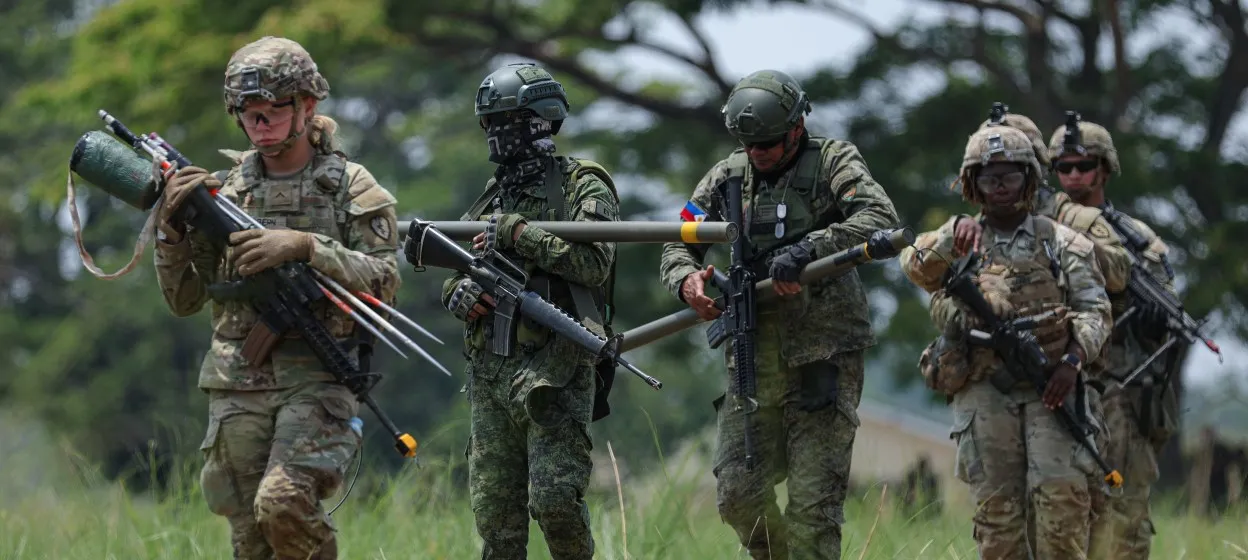The United States for long has been aiming for an anti-China front in the South China Sea (SCS) via allies, enhanced state craft and military technology. Following the release of the US National Defense Policy 2022, calling for an integrated presence against China, the fiscal budget 2023 set aside another $130 billion for the Rapid Defense Experimentation Reserve that funds parts of the department to work collectively for critical joint warfighting gaps; the highest spent in DOD history (Lopez, 2022).
Some of the most prominent developments have been made to the US-Philippines Enhanced Defense Cooperation Agreement (EDCA). Particularly noted by the Philippines government’s re-release of grants to four bases under the 014 EDCA (Lema & Klamann, 2023).
Initially these sites in 2014 had been used for joint practices; however, since the release of the Integrated Deterrence policy, these bases are now being used specifically for joint forces and capabilities to deter China (Lema, 2023). These bases include the Fort Magsaysay Airfield, Basa Air Base, Mactan Benito Euben Air base, Antonio Batista airbase and the Lumbia airfield. For US military stationed at these bases, the US Embassy at Manila declared an allocation worth $11.4 million for Fort Magsaysay, $1.8 million for Antonio Bautista; $2.7 million for the Benito Ebuen and $3.7 million for the Lumbia Air Base (Acosta, 2023).
Fort Magsaysay Airfield provides one of the airports to the US in the region. In April 2023, the US Marine Corps CH-53e Super Stallions landed at Fort Magsaysay as it began to bring US and Australian troops for training during the biggest ever joint military drills, the Balikatan 2023. It was a 3-week training program on amphibious operations, urban operations, humanitarian assistance, command and control, and counterterrorism (Aguilar, 2023). The exercise included anti-tank and small arms fire as well as the firing of the High Mobility Artillery Rocket System (Portugal, 2023). Another set of training i.e. ALON 2025, between the 3 states took place in August. Deploying AFP’s ATMOS 155-mm Self-propelled Howitzer and ADF’s 155 M777 Howitzer. The exercise involved a defense operation of the fort from Northern Luzon and an advance south (ABANILLA, 2025).
The Basa Air Base hosts the Philippine Air Force’s 5th Fighr Wing’s F2-equipped 6th Squadron and the armed AS-211-equipped 7th. It was also used for the placement of PAF’s Aerobatic Squadrons, the “Blue Diamonds” and the “Red Aces” (Philippine Air Force, 2023). As of the current agreement the US has paid $24 million for the rehab of the base with the construction of the 10,000-foot runway (long enough to host any of the US military aircrafts) and $66 million for other projects including warehouse, fuel storage tanks (for extended air operations without extended support), a 625,000-square-foot aircraft parking apron, advanced radar systems and fortified facilities capable to supporting 5th generation fighter jets. The apron will become a parking spot for 20 aircraft (18 small and 2 larger) alongside a fire control system (Robson, 2023). The Basa air base currently hosts the fighter squadron of 12 Korean-made FA-50PH Fighting Eagles; these trained with the US F22 for the first time in 2023. The Philippine government is selecting an additional Multi-Role Fighter program, most likely to be the American F-16 Fighting Falcon, which will also be stationed at the base (Lariosa, 2024).
The Basa Air Base is strategically closest to the contested Scarborough Shoal, allowing a massive package for the Philippines to deter China by the US presence. It enables both states to place their warfighters closest to the contested areas of the SCS region (Heydarian, 2023).
The Mactan Benito Ebuen Air Base is one of the original sites of the EDCA. The US has spent $2 million to fund the construction of a two-fuel depot, which is near to 28% complete. These fuel depots will be used for the refueling of fighter jets during a confrontation. Being able to store around 40,000 liters these can fuel 10 Lockheed C-130 aircraft; strengthening interoperability between the US and Philippines forces in responding together.
The Antonio Bautista Air Base, closest to the Spratly Islands, enjoys a 9,000-foot-long runway compared to the provincial Puerto Princesa Airport. In July 2023, the US Marines i.e. the 2nd battalion, 5th Regiment, the 1st Marine Division, and the Philippine Marines conducted drills during the Marine Aviation Support Activity. The drills were aimed at enhancing interoperability and coordination of both forces for their mutual defense (Barton, 2023).
Lastly the Lumbia Air Base, originally serving as the main airport, now serves as one of the minor air bases that has the equipment of OV 10 Boronco Aircraft and the UH 1 Huey and MD 520 MG defender helicopters (Köhler, 2022). The US government allocated $3.7 million for the renovation at the airbase, including a runway and parking apron (Oro, 2023). After construction, it is now ready for US troops to move in. The base is now under the control and monitoring of the 10th Tactical Operations Group of the Philippine Air Force, which will work with US forces for increased cohesion in working ability (CDO EncycloPedia, 2016).
Additionally, the Philippines government has announced another four bases under the EDCA that will be used and accessed by the US military. These sites include Naval Base Camilo Osias in Santa Ana, Cagayan; Camp Melchor Dela Cruz in Gamu, Isabela; Balabac Island in Palawan; and Lal-lo Airport in Cagayan (Locations of Four New EDCA Sites, 2023). The Philippines can also serve as a great place to position the batter and the Block Va tomahawk missiles e.g. if placed at the Basa Air Base, or at the Antonia Bautista base, these missiles could efficiently target have a range to the Taiwan strait thereby contain any Chinese movement towards Taiwan or the Philippines’ islands in the region.
The US has also announced the construction of a port on remote Batanes islands facing the island of Taiwan (Tang, 2023). Less than 200km from Taiwan, the post will have access to the Bashi Channel placed between the islands and Taiwan; vital choke points which give pathway to vessels moving from western pacific and SCS. It serves as a key waterway in case of a military confrontation considering it gives quick access as well as containing Chinese ships that regularly pass through the channel. Military officials have reflected that the US is interested in radar and monitoring capabilities for the port. (Lema & Mcpherson, 2023)
While the Pentagon prepares for forward presence and aims to balance out Chinese military presence in SCS, the US developments aren’t as strategic as planned. The US has sophisticatedly traced its developments with missiles, squads and radar systems, these are still in range of PRC’s extended missile capabilities. PRC’s 1000 medium-range ballistic missiles (including DF-16 SRBM, HN2 Cruise missiles etc) and 500 intermediate-range ballistic missiles (DF-4 IRBM, HN-1 Cruise missile etc), give China the range from 1000-5,500kms, that in a conflict situation allow it to target all US regional bases with the first and second island chains.
To adapt, the US is integrating forces with allies, rather than relying on a few vulnerable platforms, the US has built smaller units with numerous and expandable weapons and locations.
However, the approach has major tradeoffs. Firstly, the US radar systems are larger and expensive to install; these are also at the target of Chinese ballistic missiles. For survival these systems must disperse and hide. The problem involves logistics and sustainment: the more dispersed, the harder it is to keep them well supplied. Similarly for these weapon systems to be successful in deterring their opponent, these must be well arranged across the first lines but in face of china, it makes it easier for the forces to identify and target these units. For example, America depends on its cyberattacks to disable PLA’s command, control, and communications. Disclosing the details of this capability would require revealing U.S. access to Chinese networks, which would give Beijing a chance to close breaches. (Cooper, 2024)
The geography also plays a crucial role when in a faceoff with China. Though the US forces are quick to reach and respond, the facts change when in face with China. If the US maintains most of its strategic presence in the first island chain, PLA could conduct a crippling first strike. If placed in the second island chain or further from the SCS, it may get late for the US forces to deter or even respond to Chinese Airforce might. (Brands, 2024)
While US developments under EDCA are worth appreciation to maintain dominance in the region, the US needs to rethink its strategic development when considering the Chinese military strength; how the US places its posture will define the stability and security for the region in the years to come.

Table of Contents
ToggleBarraq Sohail
Barraq Sohail is an independent researcher. Graduated with a BS in International Relations from Kinnaird College, she interned at CSSPR and ISPR; currently serving as the Communications Manager in Global Defense Insight.













